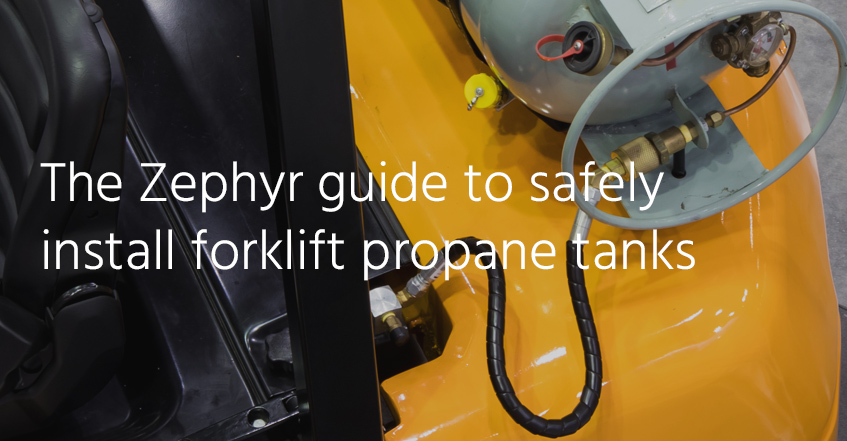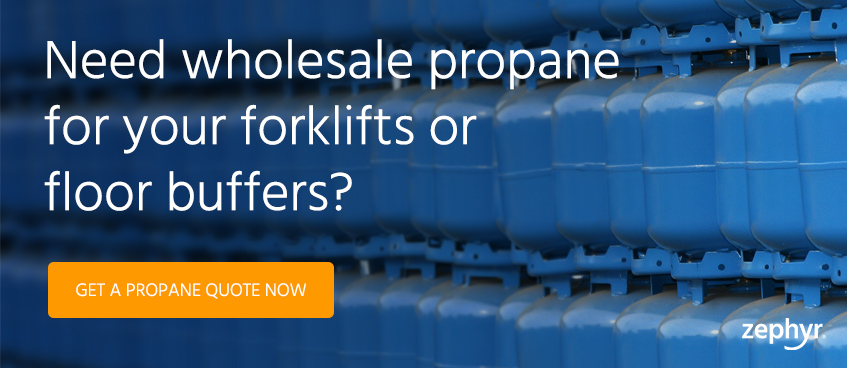Use this guide to safely install forklift liquid propane tanks and ensure maximum operations for your company with minimal risk to your staff.
Liquid propane (LP) is arguably the most powerful and cost-effective method for powering heavy machinery like forklifts. However, since it is a flammable fuel it must be handled and treated with care.
Follow this guide on how to remove and install forklift LP tanks and you’ll ensure the safety of your coworkers, and yourself.
1. Safety first
Always begin by wearing your PPE. That’s Personal Protective Equipment— safety goggles that wrap fully around your eyes and heavy-duty rubber gloves. The propane inside your high pressure tank hovers around -42°F. Any direct contact can cause frostbite or irreversible damage to the eyes.
If you can, swap the tanks outside. If you are installing indoors, make sure you’re in a well-ventilated area with plenty of space.
Finally, and this should be an obvious one— do not install LP tanks anywhere near ignition sources. Never smoke around liquid propane tanks.
2. Check for residual fuel
Before disconnecting anything, make sure that there is no fuel left in the tank or lines. Engine trouble does happen, so do not assume that just because the forklift has shut off that it’s because it’s out of fuel. If propane is still in the system when the coupler is disconnected, the fuel can spray out onto your arms or face.
3. Disconnect
Turn off the service valve on the empty propane cylinder. Disconnect the gas line by unscrewing the service connection, watching for any residual fuel. Remove the empty tank and store it properly following your company’s tank storage protocol.
4. Check for leaks
Any leak in a fuel system or tank can result in fires or explosion. Take the time to inspect your propane tanks for anything irregular. This includes rust, frost accumulation, dents or dings in the cylinder, or any other visible damage. Check to make sure the O-ring is not nicked or damaged in any way. A nicked O-ring can often result in leaking gas. Check the hoses and fittings on the forklift for and signs of damage.
5. Installing forklift liquid propane tanks
Carefully set the new, full tank on the locating pin. The locating pin is critical as it positions the cylinder appropriately for connection to the hose fittings. If the tank is not set on the pin properly it can result in stretching or twisting of the hoses, which can lead to cracks or bursts in the hose.
Proper installation of the LP tank on the locating pin also ensures the pressure release valve won’t spray any fuel. It also allows your fuel gauge to read correctly and it aligns the main valve tubing inside the propane tank to ensure a full emptying of any remaining gas settled at the bottom of the cylinder.
6. Connections
Make sure the valve on the new LP tank is turned OFF. Also check that the O-ring from the empty tank did not come loose or get stuck in the check valve during removal. Then, with the tank valve off, screw the forklift connection completely onto the tank fitting, taking care not to over-tighten. Next, open the tank valve slowly to the ON position.
7. Check for leaks
After you’ve installed the new LP tank on the forklift, check again for leaks. You should not smell any gas or see any visible frost or white residue. Listen for hissing noises. You can also check for leaks by wiping a solution of 1 part soap and 1 part water over the tank connections. A presence of a leak will create growing bubbles in the soapy mixture. If you believe the tank is leaking, immediately shut off the tank valve and open windows or doors to ventilate the area.
8. Where to buy forklift liquid propane tanks
Zephyr Solutions is your industrial, national supplier of liquid propane tanks for forklifts and for floor burnishers. Get a free propane quote from us here.


